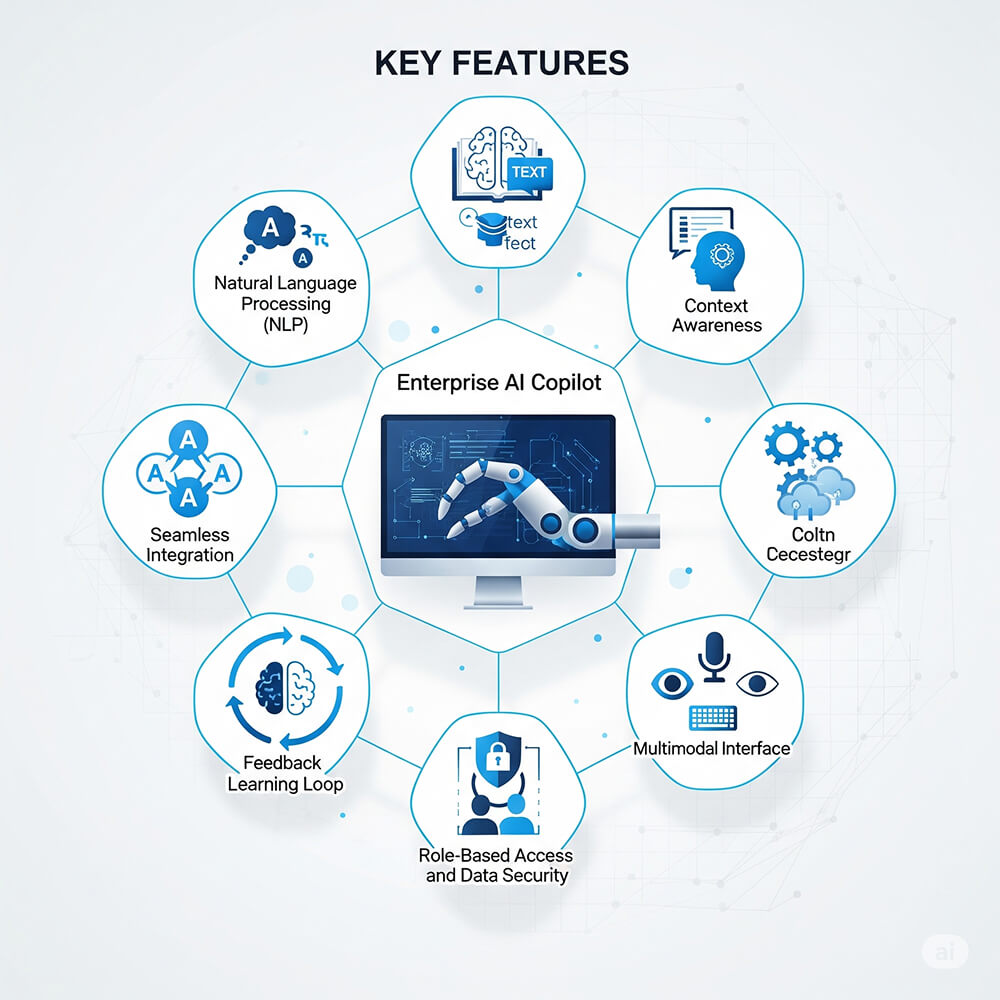How to Develop an AI Copilot for Enterprise: A Complete Guide to the Process, Features, and Cost

The business world is abuzz with the potential of AI. With the success of consumer-facing tools like GitHub Copilot and Microsoft Copilot, enterprise leaders are now asking a crucial question: "How can we harness this technology to benefit our own organizations?" The answer lies in the AI Copilot for Enterprise—an intelligent assistant designed to streamline complex business workflows, boost productivity, and empower employees with data-driven insights.
However, implementing such a solution is a complex undertaking, rife with technical challenges and strategic decisions. This AI Development Guide for Businesses is designed to demystify the process. We will walk you through the entire journey, from initial concept to a fully deployed solution. This guide explains how to develop an AI copilot for your enterprise, covering the process, features, and cost considerations.
What is an AI Copilot for Enterprise?
An AI Copilot for Enterprise is more than a simple chatbot or a virtual assistant; it’s a sophisticated Intelligent Business Assistant deeply integrated into your company’s unique workflows and data. While a basic chatbot handles simple queries based on pre-programmed scripts, an AI copilot leverages large language models (LLMs) and your proprietary data to perform complex, context-aware tasks.
Think of it this way: a chatbot is like a customer service rep who can only answer FAQs. An AI copilot is like a seasoned colleague who understands the history of a project, can access critical documents, and can assist with strategic tasks. These AI-Powered Enterprise Tools are designed to be proactive, predictive, and personalized.
Here are some real-world examples of how they work:
- Finance Copilot: Instead of manually pulling data from various sources to create a quarterly report, the copilot can automatically gather the information, generate the report, and even highlight key trends or anomalies, saving hours of manual work.
- Operations Copilot: HR Copilot: An HR assistant can automatically screen resumes for specific keywords and qualifications, schedule interviews, and even draft initial rejection or offer letters based on pre-approved templates. This transforms the tedious hiring process into an efficient workflow.
- Operations Copilot: An assistant integrated with your supply chain data can monitor real-time logistics information, predict potential delays, and even suggest alternative shipping routes or suppliers to mitigate risks.
These examples highlight how an AI Assistant for Enterprise Workflows can go beyond basic automation to provide genuine, intelligent support for critical business functions.
Why Enterprises Are Investing in AI Copilots

The motivation behind developing custom AI copilots isn’t just about embracing new technology—it's about achieving tangible business outcomes. The benefits are wide-ranging and directly impact the bottom line. Businesses are increasingly looking to build AI Copilot solutions to gain a competitive edge.
The primary driver is time and cost efficiency. By automating repetitive, time-consuming tasks, employees are freed up to focus on higher-value work that requires creativity, critical thinking, and human interaction. For example, a marketing copilot could generate initial social media posts or email campaign drafts, allowing a marketing specialist to focus on strategy and engagement. This AI for Business Automation leads to significant cost savings and improved productivity across the board.
AI copilots also enable data-driven decision-making at every level of the organization. By acting as a central hub for disparate data sources, an intelligent copilot can summarize complex reports, analyze market trends, and provide actionable insights in real-time. This empowers managers to make more informed choices faster.
Another major benefit is a notable improvement in employee productivity. With a copilot handling administrative burdens, employees can spend more time on strategic initiatives and innovative projects. This not only makes their work more impactful but also boosts job satisfaction and morale. An AI solution becomes a valuable partner, not a replacement.
AI Copilot Development Process

Developing a custom AI Copilot requires a structured and thoughtful approach. Skipping steps can lead to a costly, ineffective solution that fails to meet business needs. Following a proven AI Copilot Development Process is essential to success.
Here is a step-by-step breakdown of how to approach Custom AI Copilot Development:
- Business Case Definition: This is the most critical first step. What problem are you trying to solve? Who is the target user? What specific business outcomes are you hoping to achieve? This phase involves defining the scope, identifying the key use cases, and establishing measurable KPIs. For example, your goal might be to reduce the time spent on creating financial reports by 50%.
- Data Integration and Preparation: Your copilot is only as good as the data it’s trained on. This stage involves identifying all the relevant data sources (databases, documents, CRMs, etc.), cleaning the data to ensure its quality, and structuring it in a way that the AI model can understand. This often involves building a robust data infrastructure.
- LLM or AI Model Selection: You’ll need to choose the right foundation for your copilot. This could involve using a major LLM like OpenAI's GPT-4, Google’s Gemini, or an open-source alternative. The choice depends on your specific needs regarding cost, security, and customization. The model will then be fine-tuned using your proprietary data.
- UI/UX Development: The user interface is the bridge between the user and the AI. Whether it’s a chat interface, a dashboard, or a plugin for an existing application, the design must be intuitive and seamlessly integrate into your employees’ daily workflows.
- MVP Prototyping: Instead of building the entire solution at once, start with a Minimum Viable Product (MVP). This is a simplified version of the copilot that solves one core problem. Building an MVP allows you to test the concept with real users, gather feedback, and iterate quickly before investing in the full-scale project.
- Testing & Quality Assurance: This is a multi-stage process. It involves standard software QA testing to ensure the copilot is bug-free, as well as human feedback loops to ensure the AI's responses are accurate, helpful, and aligned with your business's tone and policies.
- Deployment and Scaling: Once the MVP is validated and refined, it's time for full-scale deployment. This involves choosing the right infrastructure (cloud or on-premise) and preparing for future growth.
- Continuous Improvement: An AI copilot is a living tool. It must be continuously monitored, updated with new data, and refined based on user feedback to remain effective. This is an ongoing process of a learning loop, ensuring the copilot gets smarter over time.
This detailed process provides a clear roadmap for How to Build an AI Copilot for Enterprise effectively and responsibly.
Key Features of an Enterprise AI Copilot

For an AI copilot to be a valuable asset rather than a novelty, it must be built with specific features that cater to enterprise needs. The best AI Copilot Features are designed to be intelligent, secure, and seamlessly integrated into existing systems.
Here are the Key Features of Enterprise AI Copilots that you should consider:
- Natural Language Processing (NLP): This is the core of any copilot. It allows the AI to understand and respond to human language in a conversational manner, making it easy for users to interact with.
- Context Awareness: A powerful copilot doesn't just respond to a query; it understands the context of the conversation and the user's role. For example, it remembers previous questions and can draw connections between different data points to provide more relevant and comprehensive answers.
- Seamless Integration: An enterprise copilot is not a standalone application. It must integrate with your existing enterprise tools, such as your ERP, CRM, Slack, Microsoft Teams, or any other proprietary software, to be truly useful. This is what allows it to access and act on your data.
- Feedback Learning Loop: This feature allows users to provide feedback on the copilot's responses ("thumbs up/thumbs down"). This feedback is then used to retrain and fine-tune the model, ensuring the copilot continuously improves its accuracy and helpfulness over time.
- Role-Based Access and Data Security: In an enterprise environment, data security is paramount. A copilot must be designed with robust security features that ensure users can only access information relevant to their role and permissions. It must adhere to strict data privacy and compliance standards.
- Multimodal Interface: While most copilots begin with a text-based chat interface, a truly advanced solution can support multiple modes of interaction, including voice commands, a visual dashboard, or even an API that allows other applications to communicate with it.
Cost of Developing an AI Copilot
The Cost of Developing an AI Copilot is a common question for enterprise leaders. The answer, however, is not one-size-fits-all. The price varies significantly based on the complexity and scope of the project.
Here are the key factors that influence the overall AI Copilot Cost:
- Complexity of Use Case: A simple copilot that answers HR policy questions is far less expensive to build than a complex financial copilot that generates detailed market analysis reports. The more intricate the logic and the more data sources required, the higher the cost.
- Data Infrastructure: If your enterprise data is scattered across multiple systems in an unstructured format, a significant portion of the budget will be allocated to data preparation, cleaning, and building a robust data infrastructure.
- Third-Party Integrations: The number and complexity of the external tools (CRMs, ERPs, etc.) that the copilot needs to integrate with will directly affect the development cost.
- Model Selection: The choice of AI model also plays a role. Using an open-source model may have lower initial costs but can require more internal expertise, while using a commercial model from a provider like OpenAI comes with API usage fees.
- Deployment: The cost also depends on whether you deploy the copilot on a cloud platform (AWS, Azure) or on-premise infrastructure. Cloud deployment offers scalability but has ongoing subscription costs, while on-premise requires a larger upfront investment.
- Ongoing Maintenance: Don’t forget to budget for ongoing costs, including model fine-tuning, infrastructure fees, and continuous updates to ensure the copilot remains effective.
While every project is unique, here is a general pricing range to help you budget:
- Entry-level Copilot (Simple use case, limited integrations): $20K–$40K
- Mid-complexity Copilot (Multiple use cases, standard integrations): $50K–$100K
- Enterprise-scale Copilot (Complex workflows, deep integrations, custom LLM fine-tuning): $100K+
Why Choose CQLsys Technologies
Developing a powerful and secure AI Copilot requires a partner with deep expertise in both AI and enterprise-level software development. At CQLsys Technologies, we are uniquely positioned to be that partner. With over 12+ years of experience and a track record of successfully delivering 4500+ projects, we have the expertise to transform your vision into a reality.
Our team has a proven track record in Enterprise AI Copilot Development, providing end-to-end services from initial strategy to post-deployment support. With offices in India and Canada, we offer a unique blend of global reach and local presence. We specialize in custom AI, cloud, and enterprise application development, ensuring that your AI solution is not only intelligent but also seamlessly integrated into your existing technology stack.
When you partner with us for Custom AI Copilot Development, you get a team committed to delivering a solution that drives measurable business value, is built with the highest standards of security, and is designed to scale with your enterprise.
Ready to Build an AI Copilot?
The future of work is intelligent, automated, and collaborative. An AI Copilot is more than just a tool; it's a strategic asset that can redefine your company's approach to productivity and innovation.
This AI Copilot Guide has provided you with a clear roadmap, but the journey to building a truly transformative solution starts with a conversation. Ready to transform your enterprise with an intelligent AI Copilot? Contact CQLsys Technologies today to build a custom AI solution that delivers real business value.
